The History of Astronomy at RPI
August, 2009
The Proudfit Observatory

The history of astronomy at RPI actually dates back several decades before the formation of RAS in 1938. Astronomy had been taught as a core discipline since the formation of the school in 1824, but there is very little in the historical record about what activities took place. Astronomy began in earnest at RPI in 1875 when Mr. and Mrs. Ebenezer Proudfit of Troy donated $15,000 to build an impressive observatory named the William Proudfit Observatory.[2] The history of this observatory is an interesting study in failed initiative. The observatory was named in honor of the Proudfit’s son, an RPI student in the class of 1877 who died in a tragic stagecoach accident at the age of 19. On November 10, 1875, the trustees accepted a proposal by the Proudfits to build an observatory in his honor, noting that the gift was not only a valuable contribution to science and learning, but also an appropriate memorial to their lamented son”.[1] The building was constructed on the precipice of the hill near where Walker Lab now stands. Some of the foundations of the building may still be intact, lying beneath what is now a small garden. The central part of this building was two stories high, and was topped with an impressive dome measuring 29 feet in diameter. The original design intended the eastern wing to be used for “meridian instruments” while the western wing would be used for “computation and a library”. The dome was by far the most interesting feature of this building and was innovative in being one of the first paper domes constructed. The Hall process had not been invented, so aluminum was still more expensive than gold, and paper was a practical material. The design and construction was overseen by Prof. Dascom Greene, a professor of mathematics and astronomy, who may be considered the inventor of the paper design. Prof. Greene provided the following rationale for paper construction:
“I ascertained that a dome of the dimensions required, constructed in any of the methods in common use, would weigh five to ten tons, and require the aid of cumbersome machinery to move it. It therefore occurred to me to obviate this objection by making the frame-work of wood, of the greatest lightness consistent with the requisite strength, and covering it with paper of a quality similar to that used in the manufacture of paper boats; the principal advantages in the use of these materials being that they admit of great perfection of form and finish, and give extreme lightness, strength, and stiffness in the structure…”

Prof. Greene contracted E. Waters & Sons, a firm in Troy known for boat manufacture, to work on the project. In 1878 they finished the paper observatory dome for the newly erected building. The construction method was almost identical to that used for paper boats: thick linen paper was formed over a mold with a wooden framework, which was removed from the mold along with the paper. Finished sections were bolted together and the joints were weatherproofed with cotton cloth saturated with white lead. The RPI dome was 29 feet in diameter and consisted of 16 sections plus a 4-foot wide shuttered opening for the telescope. The paper material was 1/6 of an inch thick and was described as “hard as wood”.[4] It weighed 4000 pounds, of which paper probably accounted for 1000 pounds. The dome was supported by six eight-inch cannon balls, which moved between grooved iron tracks, allowing the dome to “be easily revolved by a moderate pressure applied directly without the aid of machinery.”[3] The method of paper dome construction was utilized in several other observatories in the Northeast, including one at West Point.[5] A patent was issued to E. Waters & Sons in 1881.
Sadly, a large telescope was never housed in the observatory due to lack of funding. However, the 1879 Record of Science and Industry lists the Proudfit as an active observatory, with Prof. Dascom Greene as director. They note that it did not yet contain a large instrument on the main pier, but did have the following instruments:
Transit Instrument. by Kubel, of Washington, of 2 inches aperture and 31 inches focal length. It is so made as to admit of ready reversal, and is provided with delicate Level and Micrometer, to adapt it for use as a zenith telescope.
Another Transit. of 2 inches aperture and 30 inches focal length, is mounted in the prime vertical.
Telescope, by Fitz, of 3 inches aperture, mounted on an equatorial stand.
For furnishing the time, there are two mean Solar Clocks and a Sidereal Chronometer.[6]
The present status of these instruments in unknown, but they may have been donated to the Smithsonian or another museum, as has occurred with several other relics at RPI.
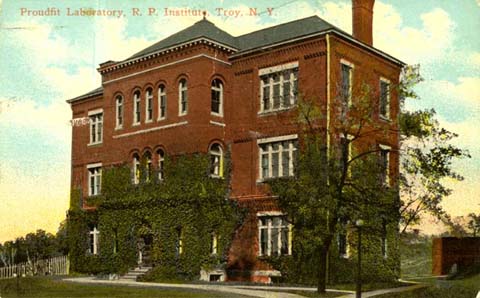
Because a large telescope was never placed in the dome, it was never much use to the university. In 1900 the dome was replaced by a roof and a second story was added to the three wings. As is a common occurrence throughout Troy and RPI history, the building was partially destroyed by fire in 1902. As part of the renovation in 1903, a third story was added and the basement deepened. The building became a laboratory for mechanical and electrical engineering. The building went through several renovations and other uses and was eventually razed in 1959. The only physical reminder of this structure is the archway keystone which is memorialized on the southern entrance of the Science Center in 1961.[2]
References
[1] Biographical Record of the Officers and Graduates of the
Rensselaer Polytechnic
Institute,
1824-1886 By Rensselaer Polytechnic Institute, Henry Bradford Nason.
Published by W.H. Young, 1887. pg 6, 22
[2] Williams Proudfit Astronomical
Observatory
RPI Archives Building Histories
[3] Cupery, Ken Paper Observatory
Domes 2001.
[4] American Architect & Building News. Jan 25, 1879, p 30.
[5] Cupery, Ken. A Short History of Paper
Boats
[6] Annual Record of Science and
Industry
1879.
Formation of the Rensselaer Astrophysical Society
The Rensselaer Astrophysical Society was founded by students in 1938. In 1940 the Board of Trustees approved the Society’s proposal to erect an observatory on the campus, which became known as “Rensselaer Observatory”. The observatory was designed by Dr. Ralph Winslow, head of the school of architecture, and construction was supervised by Physics Professor G. Howard Carragan. It was built on a small ridge just south of Russell Sage Dining Hall, where the Low Center now stands. The observatory was dedicated in September 1942 in an address by Professor Bart J. Bok, then a member of Harvard College Observatory. The 12” reflector was built on campus was sheltered under a 16’ dome. The observatory was featured in the October of 1942 issue of Sky and Telescope Magazine. (see scans above)
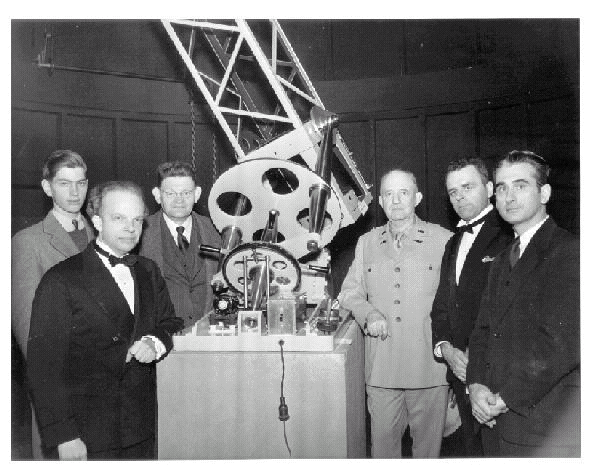
Dedication Ceremony. Left to right: Westbrook (Astrophysics Society), G H Carragan, O Rasmussen, President W O Hotchkins, B J Bok (Harvard College Observatory), Winslow (RPI Professor)
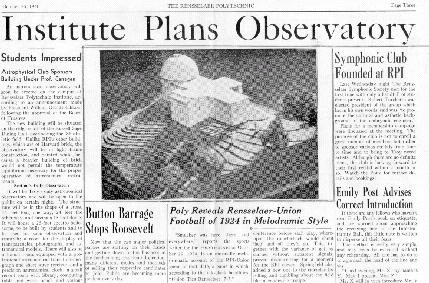
Article from The Rensselaer Polytechnic, October 1940
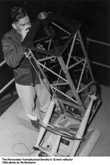
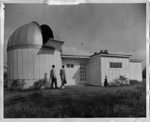
The 12” equatorial reflector is shown in use prior to the observatory (left) as well at the 1942 dedication. Today, the instrument sits on display in the lobby of the observatory as a testament to the fine craftsmanship of Otto Rasmussen, the department’s instrument maker, who oversaw the construction effort, as well as the RAS members who assisted. Mr. and Mrs. Rasmussen also donated an astronomical clock, the present whereabouts of which is unknown.
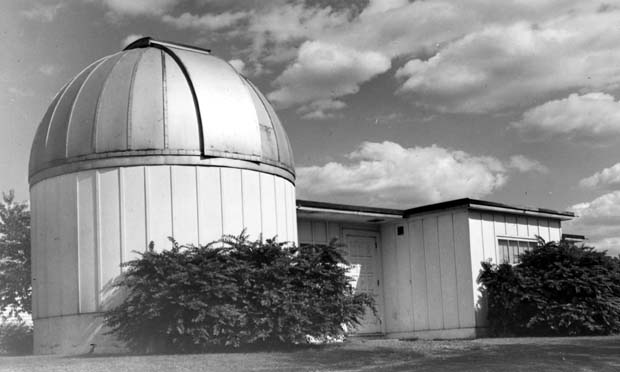
The Observatory, circa 1942.
 The Original Observatory Layout
The Original Observatory Layout
During that time, a special radio frequency clock was used, which received time signals from Washington. The Rensselaer Observatory also had a variety of smaller instruments. In 1946, two refracting telescopes were donated to the observatory. The first was a 6” refractor, given by Mr. Roland B. Bourne (‘20), which was mounted on a B-29 gun turret. The second was a 5 1/4” refractor given by Mr. Gabriel R. Solomon ‘02.[1][2] It is believed that this telescope is the 1883 John Byrne refractor which still remains at the observatory. Mr. Solomon was a distinguished graduate, a professional engineer and businessman who traveled the world and became rich working as a civil, mechanical and electrical engineer.[3] We also know that the observatory had a 3 1/2” refractor, and a 3” Ross photographic telescope with a Ross-Fecker camera. There was also a small solar observatory and heliostat outside, which tracked the sun and reflected a beam of sunlight into the building. Additionally, when Mr. Rasmussen retired in 1952, his 6” reflector was purchased by the physics department.[2] The observatory continued to be a popular local attraction. In 1954, 900 visitors were reported to have visited the observatory, [2] and in 1957 there were 2400 visitors.
References:
[1] “Report of the 1946 Activities of the Rensselaer Observatory”
Fleischer, Robert. RPI Archives.
[2] “Reports of
Observations”
Astronomical Journal, Vol. 59, p. 335
[3] Who’s who in the Construction Division of the United States
Army
Radio Astronomy and the Sampson Station
Today not many people realize that RPI was once a hotbed for radio astronomy. The campaign to bring radio astronomy to RPI was led by Dr. Robert Fleischer. Dr. Fleischer was very dedicated to expanding astrophysical research at RPI and also dedicated numerous hours sharing science with the public at the Rensselaer Observatory. He was went to school at Harvard, receiving his BS in 1940, MA in 1947, and PhD in 1949, with research interests in geophysics and solar-terrestrial relations. Fleischer joined the faculty at RPI, advancing to Full Professor in 1958. His obituary states “It is a testament to his character that without his enormous energy, organizational, and fundraising abilities, the radio telescope project languished after he left.”[1] Dr. Fleischer had big dreams for astronomy at RPI, a few of which came to fruition, while others are now left for future generations to fulfill.
In January 1956, Dr. Fleischer wrote a lengthily proposal arguing that the venerable Dudley Observatory should merge with RPI and construct a new observatory at a site in Grafton Lakes State Park. This new observatory would house the Dudley’s precious 13” 1860 refractor and 12” 1893 Pruyn Equatorial Telescope as well as an extensive library of rare books. Furthermore, a new radio telescope would be constructed at the site, the plans for which had apparently had already been discussed. Ultimately, the merger did not happen, but Dudley, along with Union College, teamed with RPI to help build and operate a radio observatory on an 820 acre tract of land in Grafton Lakes State Park. The site was chosen because of its relative isolation from electrical lines and other sources of radio noise. The station was named “Sampson Station” in honor of Dr. John A Sampson, who bequeathed the property to RPI.[2] A dedication ceremony was held on June 30, 1957 in conjunction with the opening of the International Geophysical Year.[2] The observatory complex was powered by a generator until a 1-mile underground electric line was completed later in 1957. A $50,000 grant was received from the Research Corporation as well as $30,000 in annual funding from the NSF. Additionally, the trustees of the Dudley provided funding, as part of the joint venture. Research staff included Dr. Alan S. Meltzer, Dr Pearl R. Lichtenstein, along with research associates Mr. Robert L Watters and Dr. Kenneth Mortenson.

I found a map of the observing site and decided to go to Grafton to look for any remains of the radio telescope. The picture above is a trailer I found after walking about 2 miles down a trail at the end of Shaver road at Grafton Lakes State park. A gate and sign announced that I was entering private property of RPI. It said No Trespassing, however, the same trail is on the Grafton map, so it appears to be part of the park now. I found the remains of the trailer at what I believe is a location marked on the map as “summer buildings”. Two buildings where shown on the map in fairly close proximity, but I only found one. It was nearly destroyed, as you can see. One reason this may have been part of the observatory is that I found an electrical conduit coming out of the ground, so it appears a buried electrical line came to the trailer at one time. I also found a field which may have been part of the observatory. Large pieces of corrugated metal were strewn in various places. A large part of the RPI property and trails was left unexplored.
A fair amount of research was performed on auroral noise and solar radio noise at Sampson Station. An abstract from 1961 discusses a 517-megacycle swept lobe interferometer with spacing of 200 feet between elements. Dr. Fleischer outlined plans to build mobile radio telescopes in buses with the seats removed. These telescopes could be constructed and then moved into position as desired. They could be rearranged to make a larger or smaller baseline depending on the sensitivity and resolution required. It is not known whether this project was completed. It is sad that after Dr. Fleischer left to work at the NSF in 1962, work at the radio observatory quickly subsided.
However, we do know that someone at RPI named J. Spalding had ambitious plans of his own.. He had ordered quotes for a 24” and 16” f/4 reflectors from Boiler and Chivens in 1963, and had drawn up detailed blueprints and plans for what he described as a “optical-radio observatory”, which included a “high power laser”. The purpose of this laser is not elucidated, but it was of such size that the plans specified a special room for the power supply. (Its likely the laser was for an early type of adaptive optics system, i.e. monitoring atmospheric turbulence, or some kind of interferometer, however that would require two telescopes, and there is only one in the plans). The plans say that it would be located at the “Crawford road site”. (there is a Crawford Road in Schenectady, NY). Evidently, none of these plans ever came to fruition.
It is not clear exactly how and when radio astronomy died at RPI, but by the 1970s the Sampson station was abandoned.
References
[1] Obituary: Robert Fleischer,
1918-2001 Bulletin of the American Astronomical Society, v. 35, no. 5, p. 1460-1461
[2] “Reports of Observatories” Astronomical Journal, Vol. 62, p. 283
The Hirsch Observatory
In 1980 the General Electric company donated the Boller and Chivens 16” Cassegrain telescope currently in use. The age of the telescope is not known exactly, but it was probably built in the mid 60s. The use of this telescope by GE prior to 1980 is also unknown, but it is the personal guess of the author that it may have been used for tracking high altitude aircraft. The extra-long focal length and high magnification would make it ideal for such purposes.
The observatory was expanded and re-dedicated to celebrate the event. A second dome was built to house the new telescope, since it was felt that the process of replacing the original telescope with the new one would cost more than simply building a new dome.
The observatory immediately became known as the “Dolly Parton Observatory” for rather obvious reasons. As a matter of fact, as a prank, a group of students painted the tops of both domes red, added red plastic buckets to the structure, and then covered the entire thing with a “brassiere” made out of bed sheets.[1]
Between 1983 and 1984 the observatory was moved (reduced in size) to the roof of the Science Center to make room for the Low Center for Industrial Innovation. The observatory was renamed the Hirsch Observatory, in honor of Hope and David Hirsch, Class of 1965 and Rensselaer Trustee, who donated money for the renovation. The telescope was mounted on top one of the concrete piers running through the building to provide a stable mount. Between 1980 and 1995 the observatory was used for photographic imaging but was not open to the public regularly. RPI student Nicole Zellner is responsible for starting the present-day public observing program in 1996. She graduated from RPI with a PhD in Multidisciplinary Science in 2001 and went on to become a professor of astrophysics and planetary science at Albion College.

In 2006 there was a $70,000 refurbishment, in which the control system and electronics were re-vamped and the telescope optics collimated. Dr. Peter Mack from Astronomical Consultants and Equipment (ACE) was contracted for the refurbishment. (Mack can be seen with RAS president Anthony Milano in the picture above.) The dome and telescope were automated with the same type of control systems found in all the world’s major research observatories. The institute considered replacing the telescope with a new one, but decided not to, since the current scope is very robust and is much heavier and stable than many newer scopes.
Today the Hirsch Observatory is used by members of the Astrophysical Society as well as students in their laboratory exercises. The RAS and members of the Physics Department offer frequent public viewing sessions at the observatory every Saturday evening 8-10pm from February to mid-November. The observatory averages around 800-900 visitors per year, and with increased publicity and outreach, this number is expected to rise.


References
[1] Not the Rensselaer Handbook : Sliding into Troy (from NTRW) (original here)
Notes on the 1883 John Byrne Refractor
(written by Dan Elton in 2009)
This telescope is a historic brass refractor bearing the signature of telescope maker John Byrne - 1883. According to some records found at the library and online, the RAS had several telescopes donated in the 1940s.( see “Reports of Observations”, Astronomical Journal, 1954) One was a 5 1/4” refractor given by Mr. Gabriel R. Solomon ‘02 around 1942. It is believed that this is the Byrne refractor we have today. Mr. Solomon was a distinguished graduate, a professional engineer and businessman. As far as John Byrne himself, he started as an apprentice of telescope maker Henry Fitz in 1847 and worked with him until Fitz’s death in 1863. He then began making Byrne signed telescopes. Earlier telescopes were f 15, and the later models were an innovation in being f9 to f10.5. A 5 inch Byrne similar to this one was used by the well know astronomer Edward Barnard to discover several comets. Also, George Hale’s second telescope was a 4” Byrne refractor. Hale went on to found the Yerkes, Mount Wilson, and Palomar observatories. This instrument is currently in a state of disrepair. It is missing its original pier mount and some elements of the focuser. It is hoped that is can be restored into working order. (here is a brief bio on Byrne)
Pictures from 2008-2009 (taken by Michael Cantore):






Archives - Mirror Overhaul Project
(Completed Summer 1998)
(This was from the old RAS website and written by Jeffrey LaCombe)
As with any viewing instrument, the quality of the image is determined by the quality of the optics. In the summer of 1998 the RAS took the primary mirror on the 16” Cassegranian telescope in for servicing. This is how we did it.
Disassembly
The process of overhauling the primary mirror on the Hirsch Observatory’s 16” Classical Cassegranian telescope began with a thorough inspection of the telescope construction. It was first determined that the focusing drawtube needed to be removed, to allow inspection of the back side of the primary mirror cell. Additionally, the counter-weights and the cone were also to be removed to allow access to the bolts which attach the primary mirror cell to the Optical Tube Assembly (OTA). Additionally, any parts of the guide scopes or support equipment and wires were removed or restrained so as to allow easier working conditions. From here, it was anticipated that the mirror and the cell would probably weigh quite a bit, and that it would be necessary to exercise caution when detaching these from the OTA.


The mirror was removed with the assistance of a temporary wooden structure constructed of 2x3 studs. The weight of the mirror and cell is probably in the 75lb range, and hence can be difficult to maneuver once the attachment bolts are removed. Two people at the minimum are necessary to lift the mirror into its final position, with additional people helping lift and inserting or removing the attachment bolts that join the cell assembly to the OTA.
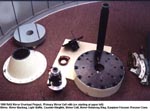
When disassembled, there are many parts to keep track of. Here we see the various major components that were detached during the procedure (left). Starting at the upper left and moving clockwise, we have the primary mirror, the mirror retaining ring, the light baffle, assorted counter-weights, the mirror cell, the focuser drawtube, and the cone.
A degree of confusion was encountered when trying to detach the mirror backing plate from the mirror.
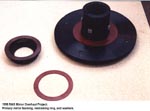
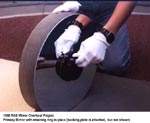
This is accomplished first by removing the retaining ring from the front via the socket cap screws. However, at this point, it is likely that the backing is still firmly attached to the mirror. The backing is removed by loosening the four set screws that extend into the backing plate from the rear (along the edges of the center tube) and cause friction pads located in the tube to expand their diameter and thereby allow adjustment (left-right etc.) of the primer mirror. Once these set screws are loosened, the backing plate should detach from the mirror.
Mirror Alignment and Collimation
By the time of its completion, the mechanical aspects of the project would prove to be the easier part. The best resource that could be found on the subject was the book “Star Testing Astronomical Telescopes” by Harold Richard Suiter (available at Orion). Unfortunately however, this resource, as well as most other mentions found online and elsewhere, only discussed adjustment of the secondary mirror in Schmidt-Cassegranians. For the case where primary mirror adjustment is necessary, they say something to the effect that we need to send it to the factory for adjustment. Since we clearly can’t do this, difficulties were in store for us!
The procedure followed was basically a best-guess adaptation of the Newtonian optics collimation method. The details won’t be discussed here. Instead, only the important tips will be mentioned. The first step was to achieve the objective (described in the text) of centering the image of the primary in the secondary mirror, as viewed from the eyepiece (a Cheshire eyepiece was helpful). This was done by moving and tilting the primary using the set screws that extend along the center tube (N/E/S/W) and four set screws that were at first concealed by cover screws with flathead screwdriver slots in them. Remove these to get access to the set screws that control the primary mirror tilt.
At this point, the quality of the image was moderate. Further adjustment was made via the secondary mirror, which has quite a few little screws to confuse matters. Some of these are actually lock-down screws, so once you figure out which to turn, the iterative process can proceed. The schematics of the secondary apparatus are available (either in the physics department or in the observatory) and were useful when determining the function of each screw.
Jeffery LaCombe, RAS Member involved in the mirror overhaul project, wrote, “At the conclusion of the rather difficult collimation process, it is my opinion that the image quality should be considerably better. However, it seemed that no amount of further adjustments would improve the image. It seems that there is a degree of astigmatism, that I can’t work out of the system. I feel that the resolving capability should be better than it is (an 8” Celestron SCT does quite a bit better on bright objects like Jupiter and Saturn). I can’t say if the resolution was ever was better in its past, but it should be in an instrument of this purported caliber. With this observation aside, it is the general consensus of the physics department users as well as the RAS club members that the telescope now exhibits considerably higher brightness, and at least as much resolving capability as it did prior to the overhaul project.”
Polar Alignment
The telescope (in general) had not been tracking all that well. Of even greater importance, the setting circles did not operate properly. It was suspected that these problems were likely due to inadequate polar alignment of the equatorial mount. This was fixed by using the star-drift method to move the mount into better alignment. Subsequent testing has shown that the setting circles are now exceptionally useful, and the tracking has improved to the point where any difficulties are now attributed to the motor drive, which appears to be in need of some work.
Resolving Ability
The September 1998 issue of Sky and Telescope magazine lists double stars in Cepheus that can be used to test the resolving ability of a telescope.
(note: table removed because formatting corrupted. See archive.org snapshot for table)
Pos. Angle denotes orientation of fainter star wrt brighter star measured CCW from north. East is at 90 and west is at 270, as would typically be seen in a telescope (i.e. east and west are swapped).
Resolution Tests
Some of the above double stars were observed to determine the resolving limit and to get an idea of the general quality of the Campus’s observing conditions. The sky conditions on this evening (10/19/98) were clear (at the time of these observations) with an extremely light haze.
| Star | Resolved? | Separation | Observing Note |
| ε Lyr | YES? | Double-Double. Main telescope could barely split them if it did at all. Brass Refractor split one definitively, but had trouble with other (but I think it did it). | |
| ξ Cep | YES | 7.9” Mag 6.4 | Pretty Easy to Split. No problems with magnitudes either. |
| Σ2836 | YES | 12” Mag 10.4 | The dimmer mag 10.4 was the faintest checked here. It was not visible in the Brass Refractor. |
| β Cep | YES | 13” | Also an easy split. |
| Σ2798 | YES | 6.4” Mag 9.9 | Both the main telescope and the Brass Refractor split this double. |
| Σ2844 | YES | 11.8” Mag 10.0 | Both telescopes split this pair. 10.0 was dimmest seen in Brass Refractor |
| Σ2843 A-B | NO | 1.5” Mag 7.7 | Main telescope could not split. Brass refractor may have just been able to split it? |
| Σ2845 | NO | 2.0” Mag 8.2 | Main telescope could not split. I don’t think Brass Refractor did either. |